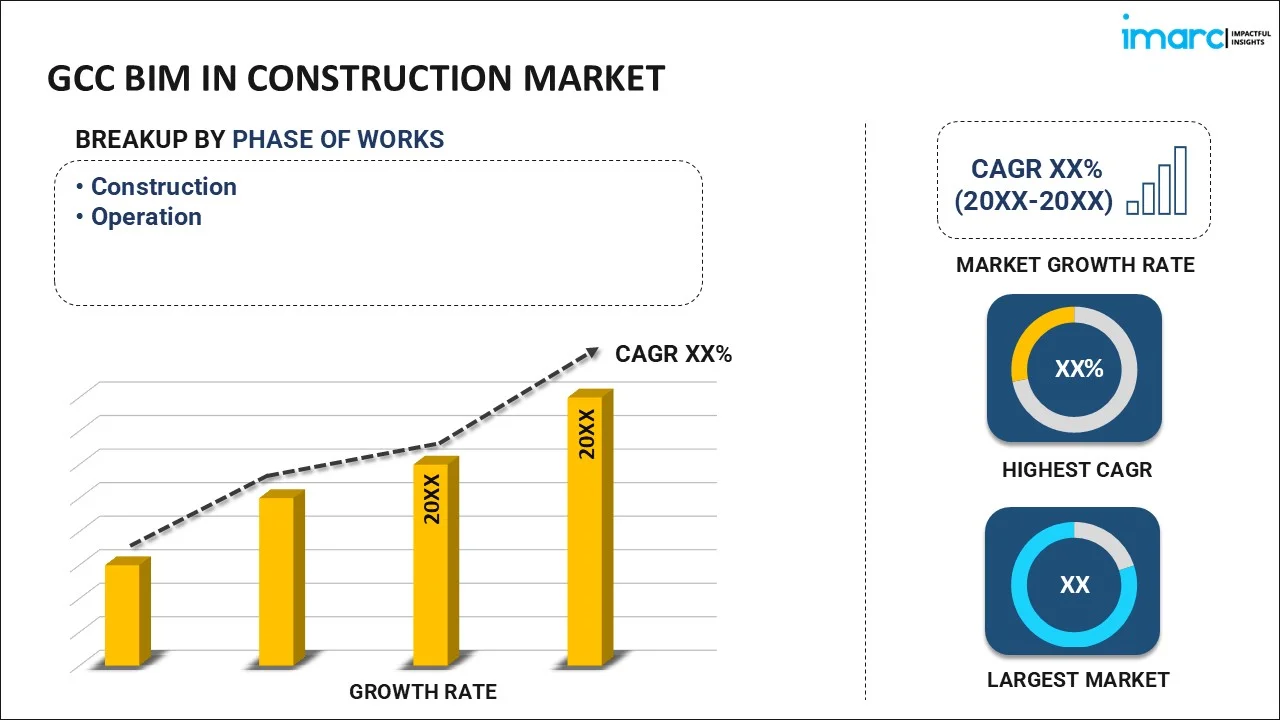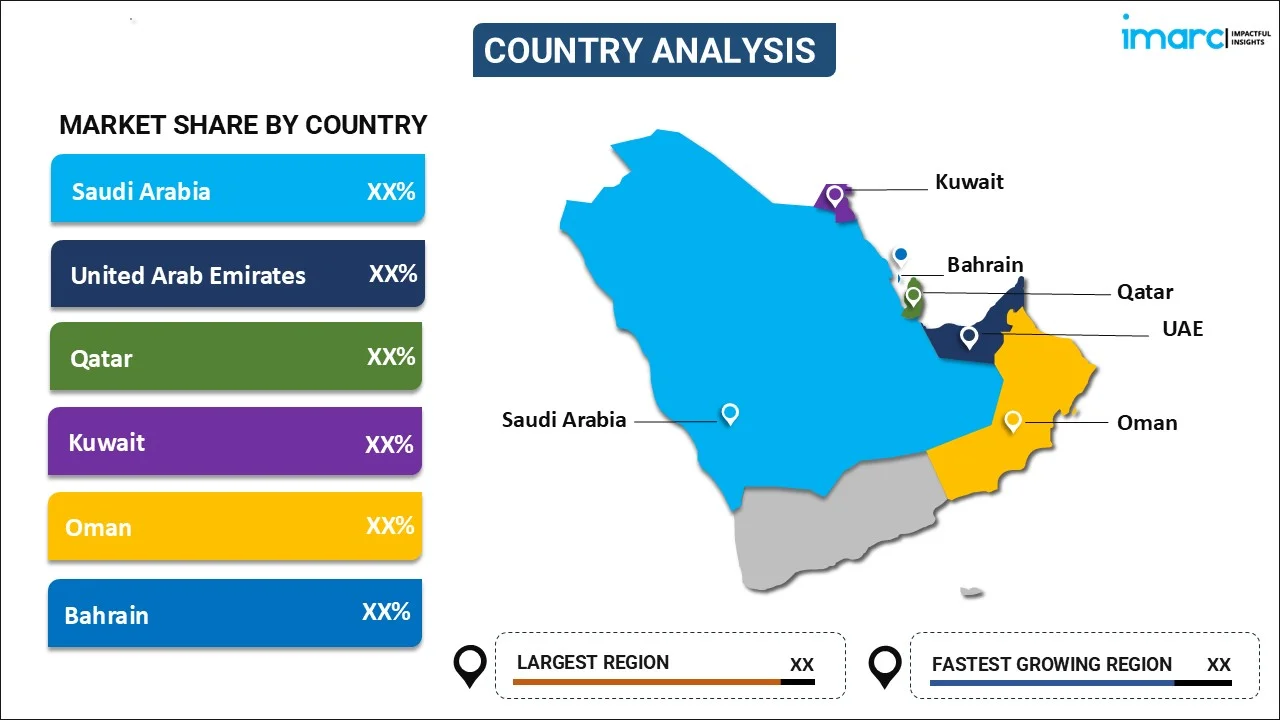
GCC BIM in Construction Market Report by Phase of Work (Construction, Operation), End-Users (Engineers, Contractors), Application (Residential, Non-Residential), Deployment Model (On-premises, Cloud-based), and Country 2025-2033
GCC BIM in Construction Market Overview:
The GCC BIM in construction market size reached USD 176.29 Million in 2024. Looking forward, IMARC Group expects the market to reach USD 517.06 Million by 2033, exhibiting a growth rate (CAGR) of 12.70% during 2025-2033. The market is growing rapidly due to favorable government initiatives and regulations, escalating demand for cost efficiency and time management, and rising focus on sustainability and smart infrastructure development.
|
Report Attribute
|
Key Statistics
|
|---|---|
|
Base Year
|
2024
|
|
Forecast Years
|
2025-2033
|
|
Historical Years
|
2019-2024
|
| Market Size in 2024 | USD 176.29 Million |
| Market Forecast in 2033 | USD 517.06 Million |
| Market Growth Rate 2025-2033 | 12.70% |
GCC BIM in Construction Market Trends:
Government Initiatives and Regulations
The GCC regional governments are implementing various national policies prioritizing the adoption of BIM to modernize construction processes and improve project outcomes. They are mandating the use of BIM for public infrastructure projects, aligning with the vision of smart cities and sustainable urban development. For instance, in 2024, Dubai introduced policies mandating 3D Building Information Models (BIM) for planning applications. Requirements include architectural BIMs for buildings over 20 floors and structural BIMs for those over 40 floors. Complexes over 20,000 sq m and specialized buildings, including hospitals and universities, must also comply. The directive aims to boost efficiency, cut costs, and improve construction standards per the Dubai Building Code and Standard BIM. Moreover, these regulations aim to enhance efficiency, transparency, and sustainability in construction, ensuring projects are delivered on time and within budget. The push from government bodies encourages wider industry adoption, fostering a unified standard across public and private sectors. Such strategic direction positions BIM as a fundamental component of future construction projects across the GCC.
Increasing Demand for Cost Efficiency and Time Management
Construction companies in the GCC face pressure to optimize resources and control costs amid large-scale development projects. BIM is an effective solution that offers advanced modeling tools that streamline project planning and execution. This technology allows for comprehensive 3D visualization, real-time collaboration, and predictive analysis, reducing risks associated with design errors and unforeseen project delays. For instance, in January 2024, 3DXB Group announced its Guinness World Record for the world’s largest 3D-printed villa in Dubai, aligning with the UAE’s goal of 25% 3D-printed buildings by 2030, and showcasing how advanced BIM technologies can optimize project timelines and reduce expenses. Integrating BIM with 3D printing underscores the industry's shift toward innovative solutions that streamline construction processes, enhance precision, and support sustainable development, meeting the rising expectations for faster, more economical project delivery.
Rising Focus on Sustainable and Smart Infrastructure
Sustainability is becoming a cornerstone in the construction strategies of GCC countries, driven by global environmental commitments and national agendas. BIM supports sustainable building practices by enabling efficient use of materials, energy modeling, and environmental impact assessments. The technology's ability to integrate data for energy consumption and lifecycle analysis promotes eco-friendly design and construction. For instance, in 2024, the Red Sea giga-project marks one of the largest, fastest capital mobilizations in construction history, featuring 50 luxury resorts powered by renewables. BIM plays a pivotal role in achieving this objective by fostering a collaborative approach that supports the integration of renewable energy sources, optimized resource use, and green building certifications. The focus on smart infrastructure, encompassing IoT and smart city solutions, further amplifies the relevance of BIM, as it provides a platform that seamlessly connects with other digital tools to enhance project performance and sustainability outcomes.
GCC BIM in Construction Market News:
- In 2024, BIM Ventures and Japan's SBI Holding launched BIM Capital, a $200 million fund at the FII8 Conference in Riyadh, supported by the Saudi Ministry of Investment. The fund targets high-growth investments in technology, emerging industries, and real estate, offering innovative financing solutions to boost economic growth in Saudi Arabia and the Middle East.
- In, 2024, SC Ventures partnered with BIM Ventures at the 24 Fintech conference in Riyadh to boost digital transformation and startup growth, aligning with Saudi Vision 2030 by combining global expertise with regional market insights.
GCC BIM in Construction Market Segmentation:
IMARC Group provides an analysis of the key trends in each segment of the market, along with forecasts at the country level for 2025-2033. Our report has categorized the market based on phase of work, end-users, application, and deployment model.
Phase of Work Insights:

- Construction
- Operation
The report has provided a detailed breakup and analysis of the market based on the phase of work. This includes construction and operation.
End-Users Insights:
- Engineers
- Contractors
A detailed breakup and analysis of the market based on the end-users have also been provided in the report. This includes engineers and contractors.
Application Insights:
- Residential
- Non-Residential
The report has provided a detailed breakup and analysis of the market based on the application. This includes residential and non-residential.
Deployment Model Insights:
- On-premises
- Cloud-based
A detailed breakup and analysis of the market based on the deployment model have also been provided in the report. This includes on-premises and cloud-based.
Country Insights:

- Saudi Arabia
- United Arab Emirates
- Qatar
- Kuwait
- Oman
- Bahrain
The report has also provided a comprehensive analysis of all the major regional markets, which include Saudi Arabia, United Arab Emirates, Qatar, Kuwait, Oman, and Bahrain.
Competitive Landscape:
The market research report has also provided a comprehensive analysis of the competitive landscape. Competitive analysis such as market structure, key player positioning, top winning strategies, competitive dashboard, and company evaluation quadrant has been covered in the report. Also, detailed profiles of all major companies have been provided.
GCC BIM in Construction Market Report Coverage:
| Report Features | Details |
|---|---|
| Base Year of the Analysis | 2024 |
| Historical Period | 2019-2024 |
| Forecast Period | 2025-2033 |
| Units | USD Million |
| Scope of the Report | Exploration of Historical Trends and Market Outlook, Industry Catalysts and Challenges, Segment-Wise Historical and Future Market Assessment:
|
| Phase of Works Covered | Construction, Operation |
| End-Users Covered | Engineers, Contractors |
| Applications Covered | Residential, Non-Residential |
| Deployment Models Covered | On-premises, Cloud-based |
| Countries Covered | Saudi Arabia, United Arab Emirates, Qatar, Kuwait, Oman, Bahrain |
| Customization Scope | 10% Free Customization |
| Post-Sale Analyst Support | 10-12 Weeks |
| Delivery Format | PDF and Excel through Email (We can also provide the editable version of the report in PPT/Word format on special request) |
Key Questions Answered in This Report:
- How has the GCC BIM in construction market performed so far and how will it perform in the coming years?
- What has been the impact of COVID-19 on the GCC BIM in construction market?
- What is the breakup of the GCC BIM in construction market on the basis of phase of work?
- What is the breakup of the GCC BIM in construction market on the basis of end-users?
- What is the breakup of the GCC BIM in construction market on the basis of application?
- What is the breakup of the GCC BIM in construction market on the basis of deployment model?
- What are the various stages in the value chain of the GCC BIM in construction market?
- What are the key driving factors and challenges in the GCC BIM in construction?
- What is the structure of the GCC BIM in construction market and who are the key players?
- What is the degree of competition in the GCC BIM in construction market?
Key Benefits for Stakeholders:
- IMARC’s industry report offers a comprehensive quantitative analysis of various market segments, historical and current market trends, market forecasts, and dynamics of the GCC BIM in construction market from 2019-2033.
- The research report provides the latest information on the market drivers, challenges, and opportunities in the GCC BIM in construction market.
- Porter's five forces analysis assist stakeholders in assessing the impact of new entrants, competitive rivalry, supplier power, buyer power, and the threat of substitution. It helps stakeholders to analyze the level of competition within the GCC BIM in construction industry and its attractiveness.
- Competitive landscape allows stakeholders to understand their competitive environment and provides an insight into the current positions of key players in the market.
Need more help?
- Speak to our experienced analysts for insights on the current market scenarios.
- Include additional segments and countries to customize the report as per your requirement.
- Gain an unparalleled competitive advantage in your domain by understanding how to utilize the report and positively impacting your operations and revenue.
- For further assistance, please connect with our analysts.
 Inquire Before Buying
Inquire Before Buying
 Speak to an Analyst
Speak to an Analyst
 Request Brochure
Request Brochure
 Request Customization
Request Customization




.webp)




.webp)












